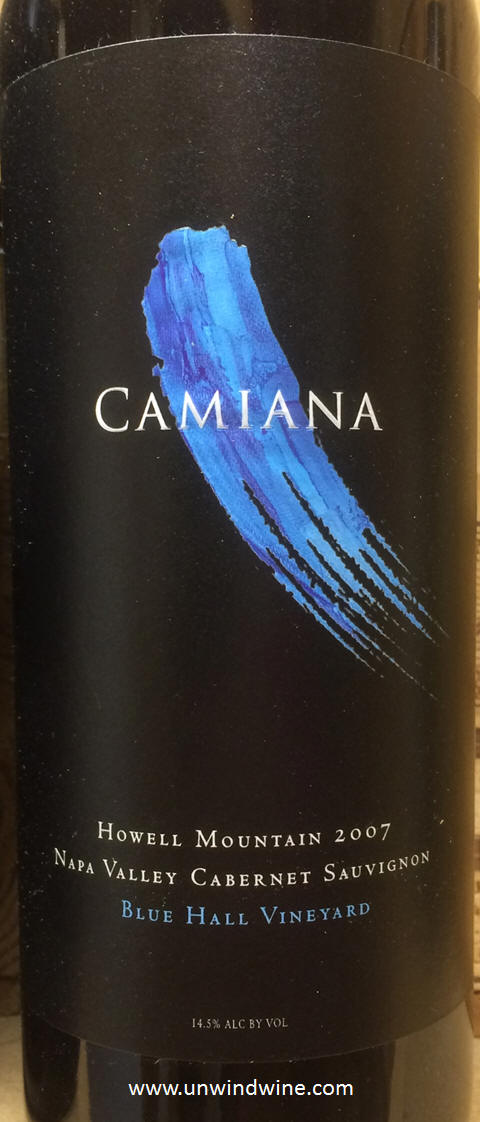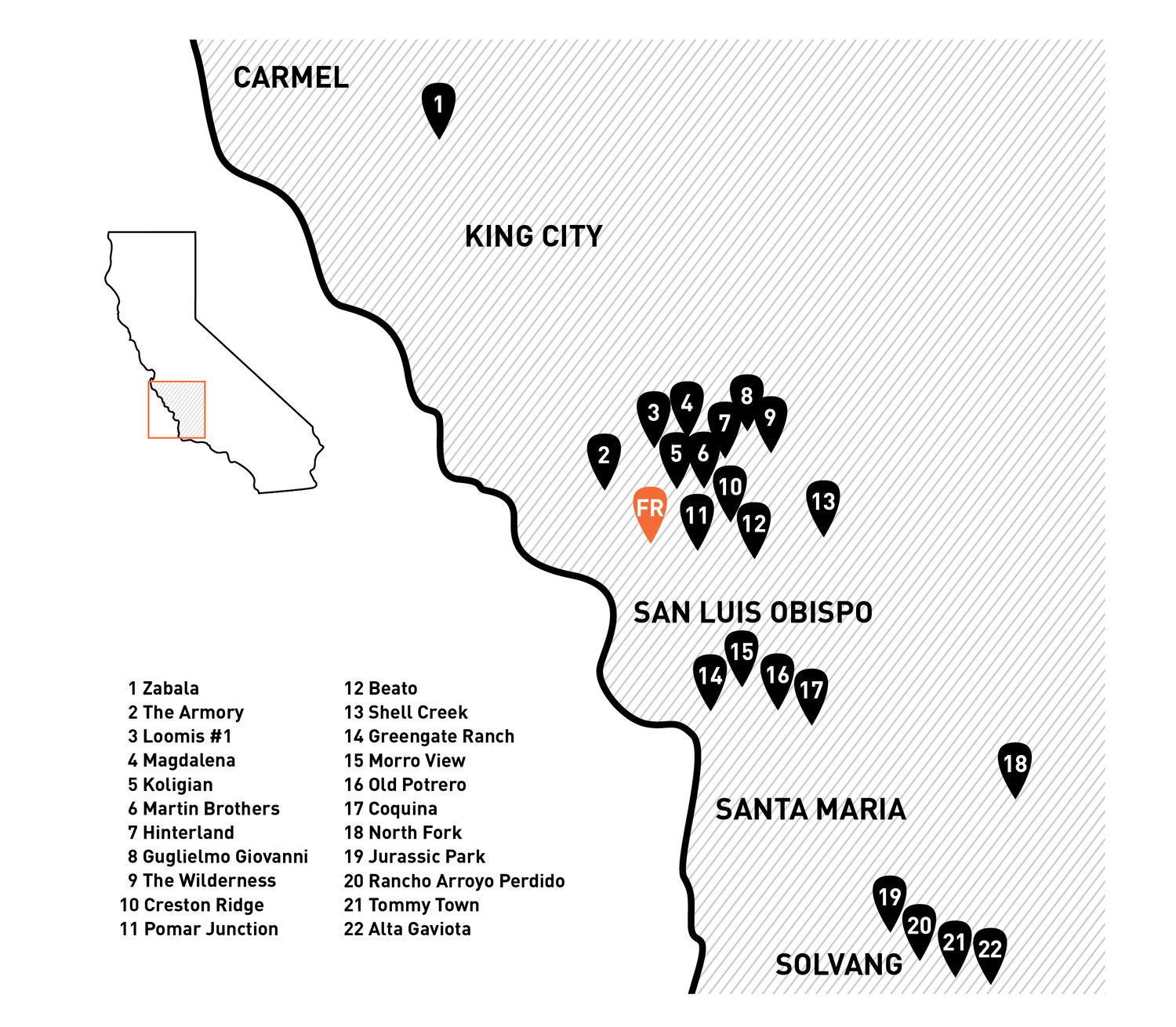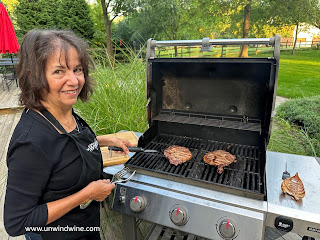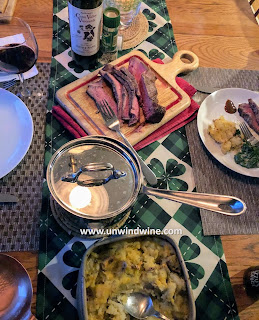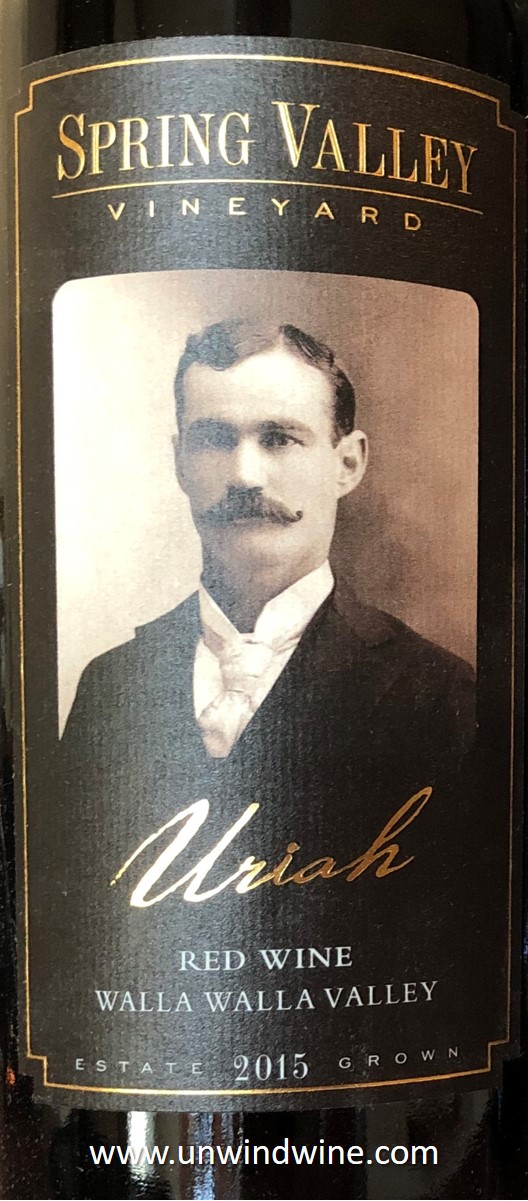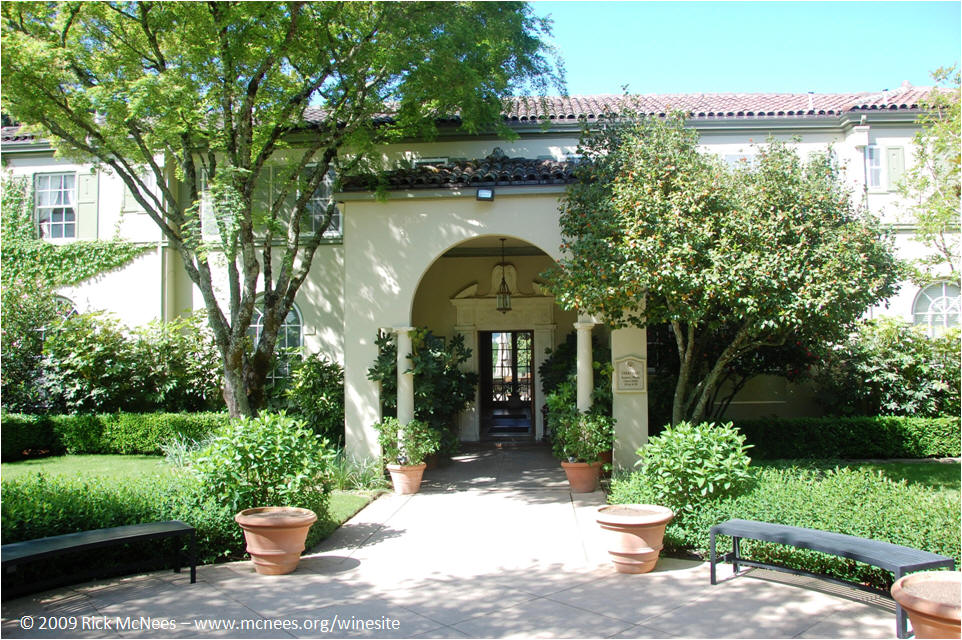Right Bank Style Bordeaux Blends and South African
Chardonnay with surf and turf dinner of lobster and grilled ribeye
beefsteaks
We
hosted neighbors Rich and Edessa for a casual Sunday evening dinner and
Linda grilled ribeye beefsteaks and lobster tail medallions for a surf and turf
dinner al dante on the deck, taking advantage of a delightfully perfect
autumn evening. Son Alec dropped in and joined us and helped select, and enjoy, the
wine (s).
De Wetshof Limestone Vineyard Robertson Valley Chardonnay 2021
Prior
to dinner with artisan cheeses, and then with ramikans of lobster
medallions with butter baked croutons, I served this interesting
Chardonnay from South Africa.
We picked this
up at Wine Discount Center downtown (Chicago) during a getaway weekend
to the City last year. They do a great job finding good QPR (quality
price ratio) wines from around the world. Regretably, they closed their
Naperville retail outlet a while back but still offer the means to shop
on-line and pick-up wines at a convenient location nearby. We've bought
many wines this way however it involves several steps in the process
including being able to pick up your purchase at a specific time on a
specific day. In any event, its an avenue to acquire some interesting
selections of wine-finds.
About 80% of the estate is planted to Chardonnay, with
various clones
matched to specific sites on the property aimed at optimal expression of
terroir. This label is the standard entry level to a portfolio of a
half dozen Chardonnays which also includes a Sauvignon Blanc, Riesling, a
"Lilya Dry Rosé", "Nature in Concert Pinot Noir" and a Cabernet
Sauvignon as well as a a "Edeloes" Noble Late Harvest aged dessert wine.
Winemaker Notes for the Limestone Vineyard Chardonnay - "Heavy
clay soils rich in limestone allow this Chardonnay to emit optimum
varietal expression in a cloak of rich complexity. An un-wooded wine,
Limestone Hill has notes of grapefruit and nuts, with the complexity
balanced by a nuanced elegance ending with a delicate ripeness."
This label was awarded 91 points by Wine & Spirits, and 90 points by both James Suckling and Wine Spectator.
This De Wetshof’s unoaked Chardonnay is grayish green and gold colored, medium bodied with crisp pear
and apple flavors with notes of lemon, apricot and crushed stones on
the nose with tangy acidity and a mineral on the pleasant zesty finish.
RM 90 points.
https://dewetshof.com/
For
the main course with the grilled rib-eye beefsteaks, I pulled from the
cellar a couple aged "Right Bank" Bordeaux varietal blends, one from Anderson's
Conn Valley Vineyards and Spring Valley Vineyards Uriah.
Anderson's
Conn Valley Vineyards "Right Bank" Napa Valley Red Blend 2006
We
served an earlier vintage release of this label and wrote about the
producer and this label in an earlier blogpost in the spring of last
year - Anderson's Conn Valley Vineyards 'Right Bank' Cuvee Napa Valley Bordeaux Blend 2004.
Just
like that night when we prepared Tomahawk Ribeye beefsteaks, I was
eager to serve the optimal food wine pairing, which as I state often in
these pages, results in heightened enjoyment of both.
I pulled from the cellar this aged Right Bank Bordeaux Blend, aptly named "Right Bank"
by the producer in light of its Merlot predominance in the Blend,
accented by another Bordeaux varietal Cabernet Franc.
Tonight's
2006 release is 77% Merlot and 23% Cabernet Franc and provided a
delightful sipping smooth polished Merlot centric red wine with a
tangy spicy edge provided by the Cabernet Franc, ideal for pairing with
the grilled beefsteak.
As I highlighted in that earlier blogpost, Oenophiles and Bordeaux enthusiasts know that a
Bordeaux Blend will comprise the classic specified Bordeaux varietal
grapes - Cabernet Sauvignon, Merlot, Cabernet Franc, Petit Verdot and
perhaps Malbec, or some combination thereof.
Those wines produced on the 'Right Bank' of the
Gironde River, to the north and east of the slightly diagonally running
river, will be predominantly Merlot based, complemented by the remaining
varietal (s) in the mix.
Meanwhile, those wines from the 'Left
Bank', to the - south and west of the river, will be predominantly
Cabernet Sauvignon, with lesser amounts of some combination of the
remaining Bordeaux varietals in the Blend.
Hence, at 77%
Merlot, this is considered a 'Right Bank' Bordeaux (Blend). Indeed, the
rear label cites they produce this wine from the two Bordeaux varietals
to be complimentary of those from the most famous Right Bank appellation,
St Emilion.
This is from Anderson’s Conn Valley Vineyards,
a family owned and operated producer founded in 1983, who released their
first vintage in 1987. This is not to be confused with Conn Creek Napa
Valley labels and brand from St Helena that go back to the 1980's.
Anderson’s
Conn Valley Vineyards produce estate Bordeaux varietal based wines from
their
40-acre estate located south of Howell Mountain in Conn Valley, just
over the first lower slope of the Vaca Range that makes up the eastern
wall of Napa Valley. Take Howell Mountain Road to Conn Valley Road which
snakes through the valley parallel to the ridgeline above Silverado
Trail, above Joseph Phelps and Hall Rutherford estates and vineyards.
They promote that they are just 3 miles or 10
minutes east of downtown St. Helena to invite visitors to their tours.
Anderson's
is run by Todd Anderson who graduated from University of Pacific in
Stockton, CA with a degree in Geology before working for a small tech
firm in seismic oil and gas exploration. Todd soon joined up with his
parents in starting a “small vineyard” in the creation of Anderson’s
Conn Valley Vineyards.
Anderson's Conn Valley Vineyards 'Right Bank' Cuvee Napa Valley Bordeaux Blend 2006
Anderson
produces a portfolio of Napa Valley sourced wines, Bordeaux varietals
and blends as well as a Pinot Noir, and Chardonnay and Sauvignon Blanc
whites.
Conn Valley’s Cabernets are made from 100% Estate grown
grapes from the vineyards located at the winery site in Conn Valley -
from their estate Cabernet Sauvignon, a Reserve, a Cabernet Franc, this
Right Bank blend and their flagship super premium Eloge blend label.
Their website library notes go back to the 2007 or 08 vintages, post
dating this 2006 vintage release.
Prior to blending and bottling, their wines are aged in the hillside caves located on the Conn Valley Estate.
According
to the rear label, winemaker for this release was Mac Sawyer, winemaker
since 2000, he sadly passed away in 2012. Owner, founding winemaker
Todd Anderson brought Mac on when they created the ultra-exclusive Ghost Horse Label.
Mac had interned at iconic Chateau
Cheval Blanc in Bordeaux,
one of the most famous top rated estates' labels in the world. No doubt
that experience formed the inspiration from the wines of
Saint-Émilion and at Cheval
Blanc, that Todd Anderson and Mac sought to recreate with this Right Bank Cuvee, crafted in the style of Cheval Blanc
from Napa Valley fruit.
The first vintage release of Right Bank Cuvee was in 2001 and was intended to
be produced only for the the annual Napa Valley charity fundraising auction Napa Premier.
The
story goes that legendary wine reviewer Robert Parker was on his annual
visit to Anderson’s Conn Valley when Todd Anderson
agreed to let Parker taste the Right Bank 2001 on the condition that he
agreed
not to publish any tasting notes.
Impressed with the wine, somehow, Parker unintentionally published
glowing tasting notes in the Wine Advocate. The ensuing demand
for the Right Bank label was so great that Todd agreed to make it part
of Anderson’s Conn Valley’s
annual portfolio.
My records show we've had a half dozen vintages
of this label that included a mini-vertical dating back to the 2003
release, including at least one vintage in large format magnum.
Tonight, this release was better than earlier tastings of earlier vintages of this label.
Robert Parker's Wine Advocate rated the 2004 release 94 points and described it,
"Their Napa Valley Cheval Blanc look-alike is called Right Bank, usually
a blend of two-thirds Merlot and the rest Cabernet Franc, although it
can change somewhat depending on the vintage. This is a thrilling wine
that comes as close as just about any wine in Napa to mimicking a great
Right Bank Bordeaux."
He rated the 2006 release
95 points back in 2009.
(RP Wine Advocate, 12/2009) and wrote, "The 2006 Right Bank (70% Merlot and 30% Cabernet Franc) exhibits
a dark plum/purple hue along with gamy, cedary, black cherry, black
currant, plum, toffee, and caramel aromas. Deep, rich, and youthful with
significant tannin as well as impressive concentration and length, this
is a stunning, complex Napa Valley red. (RP)
(12/2009)"
Like the 2004 two years ago at eighteen years, the
2006', at seventeen years fill level, label, foil and most importantly
the
cork were all in nearly ideal condition. The cork, shown, exhibited
slight evidence of past seepage and the label was soiled from excessive
humidity in the cellar at some point over the last decade.
Unlike the 2004 in the previous tasting, (https://www.cellartracker.com/wine.asp?iWine=274955), when it seemed to be
"waning on the back side of its peak drinking window signaling it may be
time to drink as it will likely start or continue to decline from here
going forward", this was still at the apex of its drinking window, albeit not likely to improve any further with age.
This
was delicious, dark
garnet colored with purple hues, medium full bodied and complex, yet
smooth and polished black berry, black currant
and plum fruits accented by notes of sweet toffee and caramel with
hints of cinnamon clove spice, anise and cedar on a long silky tannin
laced finish.
RM 93 points.
https://www.cellartracker.com/wine.asp?iWine=596492
https://www.connvalleyvineyards.com/https://twitter.com/ConnValley
As
we neared the end of the bottle of "Right Bank", I elected to fetch
another similar style wine for a comparison tasting. After discussion on
our options, Alec and I went to the cellar to pull the follow on
selection for our tasting flight. We went back and forth on the vintage
selection and ended up bringing up two vintages.
Uriah Spring Valley Vineyard Red Blend 2013 and 2015
This
provided an interesting comparison in a mini-vertical tasting, showing a
disparate contrast in two vintages of the same label.
I reviewed this wine in an earlier blogpost in these pages - Spring Valley 2013 Blends - Uriah vs Frederick, a comparison tasting between two different Spring Valley wines, their Right Bank, Uriah, and their Left Bank Frederich.
Spring Valley Vineyard 2013 Walla Walla Valley Red Wine Bordeaux Blends - Uriah vs Frederick
Tonight, this
pair of two red
wine blends of the same style and blend as our other selection, from
different vintages of the same wine provided a comparative tasting in a
mini-vertical tasting, as well as a ideal comparison tasting flight.
We visited Spring Valley during our
appellation visit to the Walla Walla (Washington) wine region in the fall of 2018. We visited the
Spring Valley Vineyard tasting room in downtown Walla Walla, then ventured out to the vineyards and winery northeast of town. There, we met
Dean Derby patriarch, and husband to Shari Corkrum
Derby, grand-daughter of Uriah Corkrum, namesake for this label.
Meeting Mr. Derby was one of the highlights of our Walla Walla Wine Experience, especially since he has since passed on. We posted a Tribute to Dean Derby and memorium of that visit - Spring Valley Vineyard toward the end of 2021.
All of the Spring Valley wines are
named for one of the ancestral or current family members.
Spring Valley Vineyard
wines are all produced from 100% estate-grown fruit, a relative rarity in
Washington.
The complete lineup of Spring Valley wines featuring the family member
labels is featured in a boxed set. Shown is our set commemorating the
2013 vintage releases.
Washington State and regional powerhouse Chateau Ste. Michelle Wine Estates purchased the winery and the brand from the
Derby family recently, but they continue to own and operate the
vineyards.
This label, Uriah,
is named for the Spring Valley Vineyards founder Uriah Corkrum,
grandfather of matriarch Shari Corkrum Derby.
Born in Walla
Walla on June 1, 1866, he began successfully farming on his own during
the 1880s. Unusual summer rain kept him from getting his harvested wheat
to the warehouse so he lost everything in the depression of 1893. He
persevered and, in 1897, acquired land in the area known as Spring
Valley that is the site of the vineyards today.
Uriah is featured on the flagship label Uriah Spring Valley Red Blend.
This is our favorite label from the Spring Valley portfolio.
The Uriah label from Spring Valley Vineyards in Walla Walla, Washington is a Right Bank Bordeaux Blend, meaning it is Merlot based like those from the northeastern or right bank of the Gironde River.
Spring Valley Vineyard Uriah Walla Walla Valley Red Wine 2013 We hold nearly a decade of vintages of this label but pulled two of the oldest, both of which we had multiple bottles.
The 2013 release of Uriah is 46% Merlot, 40% Cabernet Franc, 6% Petit Verdot, 5%
Cabernet Sauvignon, 3% Malbec.
Being
a blend of five Bordeaux
varietals, this was more complex than the 'simpler' Right Bank that only
contained two. I often compare the profile of blended wines to their
width and
depth - imagine a bar chart with five bars vs one with three.
This release was awarded 93 points by Wine Spectator,
92 points
Vinous
and Wine Enthusiast. Vinous in their review also mentioned both labels in their review, "Incidentally, this wine and the Frederick are Spring Valley's most
important bottlings, with about 3,000 cases of each produced.
The
Merlot base exudes smoothness while the Cabernet Franc spiciness shines
through. This was dark garnet colored, medium full bodied, Wine
Spectator called it 'broad and expressive', black berry and black
raspberry fruits accented by pepper, spice, black olive and notes of
black olive, expresso and green herbs turning to fine grained tannins on
a lingering finish.
This was not a smooth, elegant or polished as the Right Bank, which was noticed by everyone at the table.
RM 90 points.
https://www.cellartracker.com/wine.asp?iWine=2296582
We then moved to the 2015 vintage release of this label, which was featured in earlier tasting posts in these pages - Uriah Spring Valley Red Blend 2015
Spring Valley Vineyard Uriah Walla Walla Valley Red Wine 2015
Spring Valley Vineyards Uriah Red Blend 2015
 |
The Spring Valley Vineyards adjacent to the
farmstead site |
These are 100% sourced from Spring Valley Vineyards in the wind-shaped Palouse Hills 12 miles
northeast of Walla Walla, amid the picturesque wheat fields of
southeastern Washington and the Blue Mountains in the distance.
The
initial block of Merlot was planted in 1993 on a southern hillside
facing southwest. The vines follow the north-south slope of the hills in
vertical rows, an orientation that when combined with the declination
of the slope, allows the vines to take optimal advantage of air
drainage, sunshine, and the reflective nature of the surrounding wheat
fields.
The 2015 vintage was one of the warmest
growing seasons on record in Washington. Warm temperatures continued
through the spring and summer, moderating slightly into fall and
extending an early harvest. Overall, 2015 saw very favorable growing
conditions, producing optimal ripening across varieties and yielding
outstanding wines throughout the region.
This 2015 release is a blend or Bordeaux varietals, 43% Cabernet Franc,
38% Merlot, 14% Cabernet Sauvignon, 3% Petit Verdot and 2% Malbec. It
was aged 18 months in 100% French oak, 40% new.
Winemaker Tasting Notes: “Our most terroir
driven blend, mostly Cabernet Franc and Merlot. A rich wine coming from
one of the warmest harvests. The tannins are velvety and the finish is
long and soft.”
~ Serge Laville, Winemaker.
This
was rated 93 Points by Wine & Spirits, 92 Points by James Suckling,
91 Points by Wine Spectator, and 90 points by Sean Sullivan of Wine
Advocate.
We hold half dozen vintages of this label and pulled two of the oldest vintage as part of effective cellar management rotation.
At
eight years this is probably at or near its peak, the apex of its drinking
profile, not likely to improve further with aging, but certainly to age
gracefully for another decade if you're patient enough to keep it that
long.
This was bright garnet colored, medium bodied, elegant polished,
rich but approachable for pleasant but sophisticated drinking, its
right-bank style blend shows vibrant black berry and dark plum fruits
with notes of cassis, spice, floral and hints of balsamic and herbs with
dusty
minerality with polished soft tannins on the lingering finish.
It was consensus of the entire group that this was better than the 2013 vintage release, but still not as polished, elegant or delightful as the first Right Bank bottle in our flight.
RM 92 points.
https://www.cellartracker.com/wine.asp?iWine=2648699
Linked referenced in this blog:
https://unwindwine.blogspot.com/2018/10/spring-valley-vineyards-tasting-and.html
https://www.springvalleyvineyard.com/





